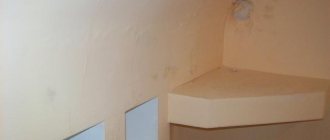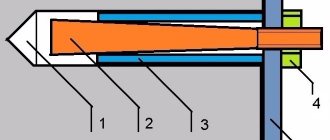It is not for nothing that popular proverbs warn about the dangers of haste in any matter. Trying to remove a mosquito net from a plastic window without understanding the design of the hooks can lead to damage. So first you need to understand how fastenings work.
We will understand the general principles of dismantling mosquito screens from windows, and also find out what to do if the ears on the frame are broken.
What is the mosquito net made of?
A classic frame mosquito repellent consists of two main parts: a frame made of hard plastic, and a mesh - a synthetic or natural fabric with a cell size of 0.8 to 1.2 mm.
Frame
The plastic from which frames are made comes in two types:
- Polyvinyl chloride (PVC) is the most common option.
- Metal-plastic - due to its high cost, is not in demand among the population and is rarely found on sale.
Both polyvinyl chloride and metal-plastic are resistant to moisture - neither prolonged autumn rains nor winter snow are a hindrance to them. However, both plastics do not tolerate low temperatures - already at -15 ° C they begin to collapse. Naturally, this process is not quick. After being exposed to mild frost for several months, the frame will not fall apart and, most likely, will retain its presentable appearance, except that the fasteners screwed into the frame will hold less well. But after two or three such winters, the mosquito net will become unusable. If you want the structure to last longer, the mesh must be removed for the winter.
Net
The fabric can be made of cotton, polyester, nylon or fiberglass. All of these materials are relatively resistant to frost, as you can see by looking at the composition of your winter clothing. However, a mosquito repellent left outside the window is exposed not only to the cold:
- periodically during thaws it becomes saturated with moisture and then freezes, causing the canvas to deform - stretch marks and tears appear on it;
- Often in winter there is a strong wind - the mesh, having lost its elasticity, cannot resist its pressure and often breaks.
What condition the mesh will be in in the spring depends on the quality of the fabric and the material from which it is made, as well as on the thickness of the threads. As a rule, after the first winter, the owners find only minor damage to the mesh, which can be easily repaired with tape and other available materials. But the second and subsequent winters are more “traumatic” - often the mesh has to be changed.
Frame mesh
In the standard version, the frame structure is a quadrangular frame of rectangular or square shape. Attached to the window in three ways:
- Z-shaped holders or on pockets.
- On hooks.
- Plungers.
Now it is clear that there can be no talk of a single, standard method of removing the mesh from a plastic window. We will look at each separately.
Holders, pockets
The principle of fixing the mesh with these elements is almost the same, so you won’t feel any difference when removing it. Using the handles on the mesh, you need to lift it all the way, and then move the lower part of the frame away from the window so much that when lowering it passes by the fasteners. This disengages the mesh from the window. Grab its edges with your hands, turn it horizontally and pull it into the room. The grid has been removed.
First, check the reliability of the handles, otherwise, at the most crucial moment, they may break and the mesh being removed will fall down. After such a fall, it will have to be repaired.
On hooks
In this case, the hooks are attached to the screen frame and hold onto the inside of the window frame. This type of fastening allows you to remove the mesh in the same way as in the fastening described above, but there is another type of metal fastening, which is also called hooks.
For this fastener, the mesh is made in such a way that it can be slightly recessed in the window opening. Each small hook is attached with one self-tapping screw and can be rotated. To remove the mesh, you need to loosen all the screws a little and turn the hooks (except for the bottom ones) inside the window. After such actions, the upper edge of the mesh moves out slightly, and the entire frame rises up and is removed from the window.
If the hook is tight to the side, then loosen the fasteners even more. If this is not done, the rubber seal may break.
On plungers
The plunger fastening is the most reliable, so the mesh secured by it is a little more difficult to remove. You must first simultaneously pull out 2 plungers from the lower profile, pull out the mesh a little, and then pull the upper plungers down. It is advisable to have a second person hold the net so that it does not fall.
Some types of plunger fastening can, together with the mosquito net, disengage from the window frame without applying additional force to them.
How to remove the mesh on the frame
The mesh on the frame is a quadrangular structure made of metal or plastic profile elements, between which a mesh fabric is stretched. It is attached to the window in one of three ways: using corners (PVC or metal), pockets, and flag fasteners. Fastening is done by the corner parts from the outside.
This mesh is removed by lifting it by the plastic handles while simultaneously tilting the lower part away from the frame. After the lower corners are released from the fastenings, the frame can be grabbed with one hand at the bottom and, turning horizontally, brought into the room.
The product with mounting angles placed on the frame is dismantled in the same way - the structure is lifted, tilted and removed from the fastenings.
The mesh is easily removed with fastening in the form of hooks (the hooks are located on the mesh and, when fixed, cling to the window profile from the inside of the room). When lifting and tilting the frame, the mosquito protection is easily separated from the window. The fasteners themselves cannot be removed from the frame.
How to remove sliding nets
Sliding-type insect screens are attached to the window using a special guide, which simultaneously acts as a rail along which the structure moves. The product may have one or two guides, which are placed at the top and (or) bottom of the frame. To remove such a mesh, lift it so that the roller comes out of the guide recess. Then the structure is lowered and removed from the window.
A pleated mosquito net is one of the sliding options. It is more compact and folds conveniently when opened. The structure should be dismantled in the same sequence as a regular sliding mesh.
How to remove screens on plungers
Pin fastening, more often called plunger fastening, is considered the strongest and most durable. It involves securing the mesh in the window opening using pins with springs inserted into specially prepared holes. To remove the structure, the pins must be removed from the recesses, for which they should be turned several times in a clockwise direction. Rotation of the elements in the opposite direction is not allowed, as this may cause the plunger to unwind and scatter into parts.
How to remove other types of meshes
To dismantle old meshes nailed or screwed with self-tapping screws, you will have to use a screwdriver or wire cutters. The fastening parts should be removed from the frame, and then the mesh itself should be removed. Holes in the frame can be sealed with tape or putty.
Nets that are attached to door or window frames using hinges must be removed from them by lifting the structure up.
Modern roll models are removed assembled along with a pencil case into which the canvas is stored.
Certain difficulties may arise when removing a mesh with a flag fastening - after all, the fastenings located on the outside must first be bent. The procedure is quite risky, so it should only be performed with insurance or with an assistant who will support you. The “flags” of the fastening from the street side are bent, while you need to lean out from the adjacent part of the window. Once the fastenings are unfastened, the mesh can be easily removed.
In principle, the process of removing the mesh is quite simple and does not require special skills. However, to avoid any hiccups or difficulties, you can perform this operation once under the guidance of specialists during installation of the structure.
How to remove the mesh from a plastic window so as not to drop it
A mosquito net installed on a window sometimes needs to be removed: this is necessary for winter storage, to extend the life of certain types of structures, or for cleaning it. Knowing how to remove the mesh from a plastic window , you can do it yourself without causing damage to the mesh frame. Removal methods may differ for different types of products.
Recommendations for removing mesh
Regardless of what type of product you have installed, if you decide to remove the mesh, you should choose dry, calm weather. The mesh has a large area, so a gust of wind can tear it off when you unscrew it, or tear it out of your hands. If it falls to the ground, the frame is likely to break. The rain will drip into your face, which is not very pleasant.
If the structure has shutters, then you won’t have to think about how to remove the mesh from the window . You just need to open one leaf and unscrew the external fasteners.
How to remove the frame mesh
- This design is easy to recognize: it consists of a metal frame with plastic or iron corners, and the mesh itself is stretched inside it.
- The corners themselves are usually located on the street side, and they are not visible from the room. Most nets have special handles, so you need to pull them up to remove them.
- Raising the frame 2 cm will release the lower fastenings, then the structure must be pulled down.
- Before removing the mosquito net from a plastic window , keep in mind that it will not just fit into the opening. It will need to be unrolled on the street and then pulled into the room.
- Remove all obstructive objects located near the window inside the room: first of all, this applies to the window sill.
- If the mesh is equipped with pockets that are screwed into the corners of the frame, it can be removed in a similar way, with the only difference that you will need to tilt it not up and down, but to the side.
- Some designs are connected with hooks. To remove such a mesh, you need to free the canvas from them without dismantling the hooks. The principle of operation is the same as in the case of attaching to pockets or corners. Details on how to repair a mosquito net with your own hands.
Common Mistakes
First of all, many are looking for special means for washing mosquito nets. In fact, they don't exist. And stores will offer expensive household chemicals containing aggressive additives. They, of course, will not melt the material, but they will easily ruin the coating that is applied to the mesh to protect it from the sun, temperature changes and other influences.
Over time, it is better to notice the new mesh
What is prohibited when cleaning a mosquito net:
- Any cleaning substances with abrasives.
- Hard brushes that can damage the protective coating.
- Vinegar. It can also damage the surface because it acts as a solvent.
- Napkins, cloth and kitchen sponges. The lint will clog the small cells. Less fresh air will enter the room, and the mesh itself will become even more clogged with dust.
- Strong water pressure without a sprayer, directed at a right angle. It is better to direct the flow at an angle of 35–45 degrees.
- Any aggression in movements. The mesh is easy to tear out of the grooves in the frame, stretch and even tear.
If you do not take into account the time for soaking and drying, then the insect protection can be cleaned in 5-10 minutes without spending a lot of energy. Those who take the time to do this as often as possible will be rewarded with additional clean air in their home.
Sources
- https://www.ivd.ru/stroitelstvo-i-remont/okna/kak-snyat-moskitnuyu-setku-s-plastikovogo-okna-5-sposobov-50041
- https://moskitnaya-setka-na-okno.ru/kak-snyat-moskitnuyu-setku-s-okna-opisanie-demontazha-raznyh-vidov/
- https://mschistota.ru/cleaning/myt-moskitnuyu-setku.html
- https://siyanie-s.ru/kak-myt-moskitnuyu-setku.html
- https://cleanqueen.ru/kak-myt-moskitnuyu-setku-v-domashnikh-usloviyakh
- https://cleaning-puls.ru/info/articles/kak-pravilno-myt-moskitnye-setki/
- https://vodakanazer.ru/novosti/layfhaki/kak-pochistit-moskitnuyu-setku.html
- https://ttbox.ru/1672-chistim-moskitnuyu-setku.html
- https://mschistota.ru/sovety/snyat-moskitnuyu-setku-s-plastikovogo-okna.html
- https://www.oknatrade.ru/help/kak-ukhazhivat-za-moskitnymi-setkami-osnovnye-pravila-ekspluatatsii/
- https://sovremennoedomovodstvo.ru/lifehack/kak-ochistit-moskitnuyu-setku/
Do I need to remove mosquito nets for the winter?
Do you need mosquito nets in winter? Of course not. Mosquito nets are designed to protect our homes from insects that fly to light and odors in spring and summer and create a lot of inconvenience. Mosquito nets do not protect against dust. They do not protect windows from children and pets. They simply do not allow small and large midges into the house or apartment.
Why leave mosquito nets on the windows during the winter? Mosquitoes, midges, flies, bees, crickets and other living creatures will no longer bother you. So why not remove the mosquito from the windows and enjoy the view outside without it? There is more light. There is less dirt on the glass. What dirt? In summer, a lot of dust settles on the mosquito net, which the autumn rain actively washes away. On the glass. And you have to wash the windows more often. Pleasure is below average, especially at sub-zero temperatures outside.
So, you need to remove the mosquito net for the winter.
- Reason one: more light, less dirt on the glass.
- Well, the second reason is shortening the service life. Mosquito nets are designed for the summer. They should not withstand sub-zero temperatures, icing, or constant exposure to water and moisture. This applies not only to plastic frames, but also to the mosquito material itself.
So our professional advice to you: mosquito nets should be removed for the winter. Always remove them from windows after the season, otherwise their service life will be reduced by at least half.
Why you need to remove mosquitoes in the fall
Why you need to remove mosquitoes in the fall
- In snowy weather, snow gets inside the cells. It can turn into frost, which will tear the cells apart.
- Under the weight of snow and ice, the mosquito sag. It won't necessarily damage it, but there is a risk. Strong winds also damage the canvas.
- At low temperatures, handles may crack and break. It will be more difficult to dismantle the structure.
- Birds can damage the mesh; they cling to it with sharp claws and rip it apart.
- Over the summer, a lot of dust will accumulate on it. Leaving the window in this form is simply unsightly, and dirt reduces the shelf life of the product. That is, dismantling is needed to clean the structure and the glass unit.
- Much less light comes through the glass with mesh, but winter time doesn’t offer sunny days anyway.
- Snow and rain contribute to the appearance of rust on the holders.
- If the product is under warranty and damaged by frost or ice, it will not be repaired free of charge. Because the operating conditions have been violated.
As you can see, it is very easy to ruin a product by leaving it on the window. Maybe it won’t tear completely, but the cells will be deformed and insects, fluff, and dust will get into the apartment through them. Therefore, we advise you to still remove the mosquito net in the fall. Use the instructions and video from the article to do it quickly and correctly.
Where and how to store mosquito nets in winter?
I think everyone understands why you need to remove mosquito nets in the winter. It remains to figure out how and where to store them correctly. Here's a little instruction for you:
- First, mosquito nets must be dismantled, that is, removed. If you can’t do this yourself due to the complexity of the fasteners, you should call a specialist. By the way, he can also adjust the fittings. At the same time. So that there is no draft in winter.
- After dismantling, you need to thoroughly wash the mesh. A soap solution and a soft cloth (ideally microfiber) are suitable for this. You cannot wash the mesh with a sponge, especially with its hard side, as it can scratch the plastic. It is also forbidden to use various washing powders when washing. And the plastic will be scratched, and the cells may become clogged.
- The next stage is drying. Not near the battery. Can be placed in the hallway or kitchen. Literally for a day.
- After drying, we recommend packing the mosquito nets in some way. You can wrap them in stretch film, you can use garbage bags or large plastic bags.
Well, now it remains to decide on the storage location. Let us immediately note that you cannot leave mosquito nets near heating appliances or in the bathroom. But you can put it on the cabinet or push it behind it.
Sequencing
- Remove screens from windows. You should not try to wash the screens without removing them from the windows. This way you will get everything dirty, and maybe even drop the net onto the street.
- Next, you need to mix the cleaning solution. We take rubber gloves and a bucket. Mix 3 parts water to 1 part ammonia in a bucket.
- It is, of course, better to wash outside or in the bath. If you wash outside, do not forget to spread the film under the net.
- First, wash off the main dirt using a hose.
- Use a hard bristle brush. Dip it into the solution we prepared and start washing the mosquito net.
- Try not to miss a single spot. Go sequentially from top to bottom.
- Don't forget to rinse your brush.
- Be sure to wash the mesh frame when you finish the mesh itself.
- Rinse the mesh on both sides of their hose.
- Inspect the mesh. Have you missed anything? If there is dirt left somewhere, repeat the procedure.
- Shake off excess moisture by simply tapping the mesh on the ground.
- Dry the mesh using a microfiber cloth.
Take it off or leave it on?
If you live in a region where winters are relatively mild - temperatures rarely drop below -5 ° C, and strong winds do not occur very often - you can leave the screen on the window. But remember: this is considered a violation of the operating rules, which means you voluntarily deprive yourself of the right to free warranty service. Any damage, even if it does not occur in winter or due to exposure to cold, will have to be repaired at your own expense.
But if you live in a region with harsh winters, leaving the net outside is out of the question. The likelihood that it will lose its functionality is too high.
How to store the mesh if you still have to remove it?
You can place it vertically or put it on a flat horizontal surface. If you choose the second option, make sure that the mesh does not experience pressure from above - placing anything on it is strictly prohibited.
What to do with anti-mosquito roller blinds?
There is no need to dismantle them for the winter, but the canvas must be rolled up inside a special box. You cannot leave the mesh stretched - it can become deformed, just like the mesh in a frame structure.
Now you know for sure whether you can leave a mosquito net on the window during the cold season. If you still decide to take a risk, remember: even if the structure looks reliable, wintering outside the window could damage its fastenings. If the frame falls off the brackets and falls down, it can cause harm to other people’s property and health, and you will have to bear responsibility for this, including financial responsibility.
Washing solution
In principle, you can clean mosquito nets with any chlorine-containing product, but ammonia has proven itself the best among folk recipes. It should be used not in concentrated form, but in diluted form. If you don’t want to prepare the solution yourself, you can always purchase a ready-made solution at a household chemicals store. Before use, read the instructions carefully.
So, how to prepare a solution with ammonia in order to properly wash a mosquito net. Pour warm water into a bucket or other container. Add ammonia to it in a ratio of 3:1. Mix the solution well. The resulting composition should be used immediately.
Recommendations from experienced users
Experienced users of mosquito nets, who have actively studied all the features of making devices, claim that sufficiently durable materials are used in production, so damage to products under the influence of winds, frost and snow is simply excluded. This is confirmed by numerous experiences using high-quality mosquito repellent devices.
But even against the backdrop of all the impeccable physical indicators, users may encounter slight sagging of mosquito nets after winter. This does not affect the design in any way, and the device itself will still effectively cope with the assigned tasks. The only negative side of such violations will be their unattractive appearance.
Users recommend removing the nets only if they are observed to sag, because in such conditions the risk of damage to the product by strong winds increases significantly. But only birds can significantly damage mosquito nets, but this risk is present at any time of the year.
When deciding what to do with mosquito nets, you need to take into account not only the opinions of experts and users, but also the recommendations of manufacturers who insist on removing the devices from the window after the summer period. This is the recommendation indicated in the instructions for all mosquito nets.
Using a vacuum cleaner
You can only use a vacuum cleaner to clean the mosquito net if your unit has power control. The nozzle should be taken with a textile spout and the power should be set to minimum. The mesh should be placed on a piece of fabric and carefully vacuumed to remove loose debris (cobwebs, dust, plant pollen). The cleaning process must be carried out on both sides of the mesh.
You can also use a washing vacuum cleaner or steam cleaner to clean the mosquito net. The mesh should always be cleaned from top to bottom. Do not forget about a cloth vacuum cleaner attachment, since the classic plastic attachment can easily damage the mesh.
Tips from the professionals
There are some nuances regarding the issue of cleaning and storing nets. This is what our factory experts advise.
- Before putting the mosquito net away for storage, it must be thoroughly washed and dried. The fact is that while it is standing on the window, the cells of the canvas become clogged with dust, particles of foliage and small insects. If you don't wash the mosquito, it may develop an unpleasant odor in the spring; in addition, a dirty mosquito on the window can adversely affect your well-being.
- To prevent the mosquito net from having to be washed again in the spring, you need to pack it for storage in a suitable-sized bag or a special case.
- A suitable storage location for the nets is a warm, heated room. However, you should not place the structures next to radiators or other heating devices. Excessive heat can also adversely affect the materials of both the frame and the canvas itself, further leading to breakdowns of the entire structure.
- To avoid stretching the canvas, it is better to store mosquitoes in a horizontal position.
- If removing and installing mosquitoes seems too labor-intensive for you, and buying a new window design every year is unacceptable for you, then the specialists of our factory recommend replacing the conventional design with a roller shutter or so-called roller design.
Rolled mesh does not require cleaning during the winter season. It is enough to simply twist it without removing it from the window and hide it in a metal box specially designed for this purpose. In this form, the construction materials will not suffer during the cold weather, and you will save your energy and time. In addition, roller shutters look great on the windows; if desired, they can be removed without any extra effort at any time.
We hope that our material was useful to you, and by following the rules for caring for a mosquito (including cleaning for the winter season) you will extend its service life.
Vinegar solution
Using a vinegar solution also shows good results for cleaning mosquito nets. The most important thing is to use a soft bristled brush to prevent the mesh from tearing or stretching.
The solution is prepared as follows: 60 percent vinegar and 40 percent water. Pour the prepared solution into the sprayer and generously spray it over the mesh previously removed from the window. Don't be afraid of the smell of vinegar; it is quite volatile and disappears completely in a couple of hours. To disinfect a mosquito net, you can use a mixture consisting of 10 percent ethyl alcohol, 50 percent vinegar and 40 percent water.











